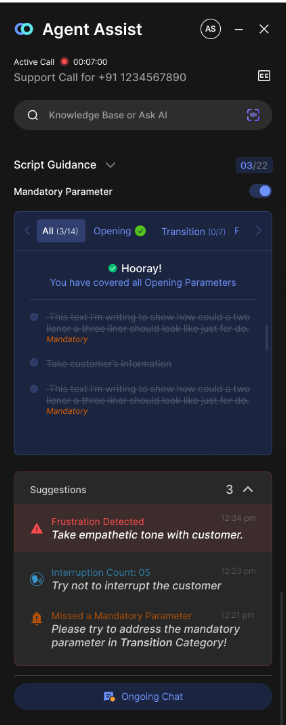In an industry where every claim, every underwriting decision, and every customer interaction can carry thousands of dollars of risk, data is no longer just a byproduct; it’s the competitive edge. The global insurance analytics market was valued at roughly USD 13.84 billion in 2024 and is projected to hit over USD 31 billion by 2030.
Amid mounting pressure from severe weather, fraud, and regulatory complexity, carriers that harness predictive analytics in insurance aren’t just adapting; they’re reshaping the game.
In this blog, you’ll get a clear roadmap for how predictive analytics in insurance powers three cornerstone functions: underwriting, fraud detection, and claims management. We’ll walk you through risk‑forecasting models, how they’re built, and how they actually influence decision‑making.
Then you’ll get a closer look at how one advanced platform, like Convin, injects customer voice, contact‑centre data, and real‑time interaction signals into insurance predictive analytics to drive sharper insights and lower losses. If you’re a VP or Head of LOB looking to turn data potential into performance advantages, this article brings actionable value.
Benchmark your risk strategy against top carriers with Convin AI

Predictive Analytics in Insurance for Underwriting and Strategy
In today’s insurance landscape, carriers are under pressure to transform from reactive claim-payers into forward-looking risk managers. By applying predictive analytics in insurance, firms can sift through millions of data points, policy history, behaviour, and external signals, to forecast what comes next.
For example, a recent industry study found that insurers leveraging advanced analytics reduced costs by up to 30% and improved loss ratios significantly.
With underwriting, claims, and fraud functions all in play, this section sets the stage for how predictive analytics in insurance is used across the value chain.
1. How insurance predictive analytics is transforming risk strategy
Insurance carriers are rethinking risk management through the lens of analytics. Predictive analytics in insurance enables a proactive approach where data drives strategy instead of experience alone.
By understanding patterns in behaviour, environmental risks, and policy history, insurers anticipate issues long before they turn into claims. A McKinsey study revealed that firms using advanced analytics improved loss ratios by several percentage points and accelerated premium growth in key market segments.
The ability to spot trends in real-time ensures that pricing, product design, and underwriting all align with real-world risks.
Ultimately, predictive analytics in insurance is helping carriers shed inefficiencies and gain agility in risk handling, something traditional models struggle to offer.
2. Role of insurance data analytics in underwriting, fraud, and claims
Predictive analytics has revolutionized underwriting, fraud detection, and claims processing by injecting intelligence into every touchpoint. Let’s break this down:
- Underwriting benefits from data streams such as telematics, public records, and IoT, which allow underwriters to move beyond traditional demographic data. According to Intellias, integrating these data sources significantly shortens the underwriting lifecycle and improves quote accuracy.
- In fraud detection, analytics tools compare incoming claims with historical data, behavioral flags, and geospatial signals. Clara Analytics found AI tools could detect fraudulent claims weeks ahead of traditional methods, slashing exposure and unnecessary payouts.
- Claims teams also benefit. Models predicting claim severity help triage efficiently; simple claims are fast-tracked, while complex ones receive deeper scrutiny. This not only reduces processing time but also aligns resources better.
The convergence of these benefits delivers a stronger, data-backed framework where risk is understood, flagged, and mitigated faster than ever.
With predictive analytics taking center stage, insurers are leaning into modeling techniques that turn risk data into forward-looking forecasts.
Use Convin AI analytics to predict policyholder behavior
Forecasting Risk with Predictive Modeling in Insurance
Forecasting risk is no longer guesswork. With predictive analytics in insurance, carriers are using statistical models and machine learning to quantify the likelihood and impact of future events, everything from natural catastrophe exposure to behavioural risk deviation.
One firm demonstrated that machine-learning models could detect potential fraud just two weeks after filing, well ahead of traditional methods.
1. Predictive modeling in insurance risk: The science behind it
Predictive modeling insurance risk involves building models that learn from structured and unstructured data, policyholder behaviour, claims history, external economic factors, and output future probability scores.
These models rely on supervised learning techniques where historical outcomes train algorithms to make forward-looking predictions.
This science helps insurers fine-tune everything from pricing to product eligibility. By adjusting inputs in real-time, the models stay agile and reflective of actual risk. As an example, Zurich Insurance reported that machine learning tools helped them refine risk profiles and improve quote-to-bind ratios in small commercial business lines.
In conclusion, predictive modeling offers a more precise understanding of risk. When embedded into daily decision-making, it creates not just efficiency but a competitive edge.
2. How risk forecasting helps insurance carriers stay ahead
Risk forecasting using predictive analytics helps insurers shift from reactive models to anticipation-led operations. With early detection of high-risk segments or regions, carriers can proactively adjust pricing or withdraw from volatile zones.
For instance, weather data integrated into models allows carriers to anticipate claim surges due to floods or storms. A study by the Geneva Association highlighted that insurers using predictive climate models responded 30% faster to weather events.
Carriers embracing predictive analytics in insurance not only prevent loss spikes but also optimize customer experience by anticipating service needs. It’s a dual win, risk control, and relationship enhancement.
Forecasting enables smarter decisions, but its true impact shows when applied directly to loss prevention and operational efficiency.
Set up real-time claim alerts to flag emerging risk with Convin AI
This blog is just the start.
Unlock the power of Convin’s AI with a live demo.

Reducing Losses with Data-Driven Insurance Analytics
Loss-ratio pressure is real; global property and casualty insurers posted a combined ratio above 100% in recent years, signalling underwriting losses.
That’s why data-driven insurance data analytics via predictive analytics in insurance is gaining ground: it’s how carriers sense trouble early and adjust course.
In this section, we’ll explore how predictive analytics in insurance drives insurance loss ratio reduction, and how real-time risk alerts transform reactive operations into proactive control.
1. Insurance loss ratio reduction using predictive tools
Insurers aiming to lower their loss ratios turn to predictive analytics in insurance to identify unprofitable policies and risky customer segments. By leveraging historical data on claims frequency and cost, carriers fine-tune their underwriting filters.
A Capgemini study found that predictive underwriting reduced avoidable claim costs by 20% across select portfolios. These models help detect fraud, allocate reserves efficiently, and improve risk-selection strategies.
In the end, using predictive tools isn’t just about loss avoidance. It’s about profitable growth and smarter capital allocation.
2. Real-time risk alerts powered by insurance data analytics
The power of real-time alerts lies in giving carriers the edge before risk becomes loss. With constant data flows from IoT, telematics, and customer interactions, carriers create dashboards that flag anomalies instantly.
According to Accenture, insurers using real-time risk alerts saw a 25% improvement in claims efficiency. This capability allows teams to act decisively, whether it's notifying customers, investigating claims, or updating pricing models.
In conclusion, real-time risk forecasting supported by robust insurance data analytics redefines agility and responsiveness for modern carriers.
Real results require real infrastructure. This is where platforms like Convin step in, powering predictive strategies with customer interaction data.
Set up real-time claim alerts to flag emerging risk with Convin AI
Convin’s Role in Enabling Insurance Predictive Analytics
The shift toward predictive analytics in insurance is not purely theoretical—it requires platforms that ingest, analyse, and action large volumes of customer interaction and operational data.
That’s where Convin steps in. By capturing rich conversation, voice, and contact-centre data, Convin supercharges insurance predictive analytics with behavioural signals that standard datasets miss.
Here we’ll map how AI voice bots, real-time agent assist, conversation intelligence, and voice of customer data feed insurance predictive analytics, and deliver value for carriers.
1. AI voice bots: How call data improves predictive models
AI voice bots have transformed data capture from passive to proactive. Every customer interaction logged by a bot is an opportunity to understand behaviour, emotion, and risk intent.
When used by insurers, these bots track policyholder questions, complaints, and tone, turning conversations into structured datasets. One implementation case by PwC noted that integrating conversational analytics led to a 40% improvement in call resolution accuracy.
As a result, insurers build better predictive models, allowing for smarter underwriting and claims forecasting. AI bots make each call a data source, at scale.

2. Real-time agent assist for faster decision-making.
Real-time agent assist enables carriers to surface the right prompts, disclosures, and scripts during live calls. This ensures accurate data capture and compliance adherence.
Agents using platforms like Convin can automatically log policyholder insights, ranging from objections to lifestyle changes. This context enriches insurance data analytics by capturing valuable variables missed in manual entries.
Ultimately, real-time assistance doesn’t just streamline agent performance. It feeds predictive analytics in insurance with clean, contextual data that sharpens every model’s accuracy.
3. Conversation intelligence for actionable insurance insights
Conversation intelligence technologies enable insurers to dissect every interaction, voice, email, or chat for sentiment, keywords, and behavioral flags. These insights identify at-risk customers, highlight process gaps, and reveal product dissatisfaction.
By turning conversations into predictive features, insurers avoid risks before they become claims. Deloitte reported that such technologies reduced lapse rates by up to 15% when applied to retention modeling.
In short, every conversation becomes both insight and input, powering a cycle of continuous model improvement.
4. Voice of customer data to fine-tune risk models
The voice of the customer is a strategic asset when captured and analyzed well. Platforms like Convin decode what policyholders really mean when they express concern or frustration.
By integrating these signals into predictive analytics in insurance, carriers achieve more nuanced risk scoring. For example, policyholders frequently calling about premium hikes may indicate sensitivity to pricing and higher churn risk.
Over time, this refined behavioral data helps insurers price more accurately, offer tailored products, and reduce risk exposure in real terms.
With the right systems in place, predictive analytics shifts from a tactical tool to a long-term strategic advantage.
Turn every call into structured, usable risk data with Convin
Predictive Analytics in Insurance is No Longer Optional
Predictive analytics in insurance is no longer a luxury; it’s the new industry baseline. As risks become more dynamic and customer expectations sharper, insurance carriers need smarter, faster, and more accurate decision-making frameworks.
From forecasting natural disasters to flagging behavioural risk signals, predictive models help insurers gain control, improve profitability, and stay ahead of loss trends.
Carriers that embed insurance data analytics into their core workflows, underwriting, fraud detection, and claims management, see measurable gains: reduced loss ratios, higher retention, and faster claims resolution.
But to truly unlock predictive potential, insurers must look beyond structured data. The customer voice, real-time interactions, and contact center signals offer untapped predictive power. This is where integrated platforms like Convin help translate everyday conversations into future-ready risk insights.
The opportunity is clear: use predictive analytics in insurance not just to protect, but to predict. If you’re ready to cut losses and gain strategic clarity, this is the time to act.
Book your Convin demo today!
FAQ
- How is predictive analytics used in insurance?
Predictive analytics in insurance is used to assess policyholder risk, detect fraud, optimize underwriting, and reduce claim losses. Carriers analyze historical claims, telematics, customer behavior, and external data to forecast outcomes. Platforms like Convin help enhance predictive accuracy by extracting actionable insights from real-time conversations and agent interactions.
- Which method is used by insurance companies to predict losses?
Insurance companies use machine learning and statistical modeling techniques, such as regression analysis, decision trees, and neural networks, to predict losses. These models analyze past claim patterns and current policyholder data to estimate the probability and severity of future claims.
- How do insurers predict risk?
Insurers predict risk by combining predictive analytics, insurance data analytics, and external risk signals. Inputs like claims history, lifestyle data, geography, and customer sentiment (captured via platforms like Convin) feed into scoring models that classify and quantify individual and portfolio-level risks.
- What are the four steps in predictive analytics?
The four key steps in predictive analytics are:
- Data Collection – Gather internal and external data.
- Data Preparation – Clean, structure, and process data for modeling.
- Model Building – Use algorithms to detect patterns and generate forecasts.
- Deployment & Monitoring – Integrate models into workflows and refine with new data.
In insurance, each step helps improve decision-making across underwriting, claims, and fraud detection.










.avif)